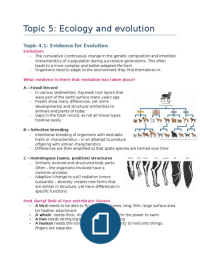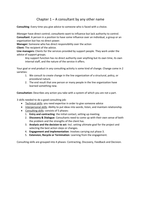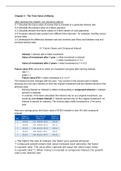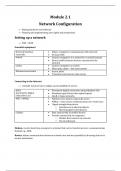Topic 4.1: Evidence for Evolution
Evolution:
- The cumulative (continuous) change in the genetic composition and inherited
characteristics of a population during successive generations. This often
leads to a more complex and better-adapted life-form.
- Organisms need to adapt to the environment they find themselves in.
What evidence is there that evolution has taken place?
A – Fossil Record
- In various sedimentary (layered) rock layers that
were part of the earth surface many years ago
- Fossils show many differences, yet some
developmental and structural similarities to
animals and plants of today
- Gaps in the fossil record, as not all tissue types
fossilise easily.
B – Selective breeding
- Intentional breeding of organisms with desirable
traits or characteristics – in an attempt to produce
offspring with similar characteristics
- Differences are then amplified so that spate species are formed over time
C – Homologous (same, position) structures
- Similarly evolved and structured body parts.
Often – the organisms involved have a
common ancestor
- Adaptive (change to suit) radiation (move
outwards) – diversity creates new forms that
are similar in structure, yet have differences in
specific functions.
Pent dactyl limb of four vertebrate classes
- A bird needs to be able to fly: thus, light bones, long, thin, large surface area
for feather attachment
- A whale needs thick, short and strong bones for the power to swim
- A lion needs strong big bones to support running
- A human needs thin bones in fingers for flexibility to hold onto things;
fingers are separate.
, Populations of a species diverge (drift
apart) into separate species – E.g.
Galapogos finches
Divergence – species branch out from an
original form, some are “successful” and stay
in an ancient form, other branches divide even
more.
The ability of species to diversify from a single
ancestral type into several forms that are each
adaptively specialised to suit a specific
environment niche.
Continuous variation across a specific geographical range of related
populations – gradual divergence
Mainland = A. They breed, and show
adaptive radiation to become specie B.
Specie B migrates to another Island,
adapts, and becomes specie C, etc.
Inter-breeding of similar species may give
rise to another specie= E
Evolution in response to environmental change
Peppered Moths
There are many examples of species with two more colours, shapes, or sizes where
the differences are completely unrelated to gender characteristics. Each of these
versions is called a morph, therefore, species that exhibit this “split-personality” are
said to be polymorphic
Polymorphism may be related to habitat diversity. The peppered moth, Biston
betularia is a well-known example of such a species.
- The light coloured morph of this moth is hard to find in the daytime when it
rests against a background of lichens growing on the bark of trees
- A dark-coloured morph is easy to see against the lichen but hard to spot
against the dark background of bare bark. Depending on the background, the
less-visible morph is the one most likely to survive bird predation.












